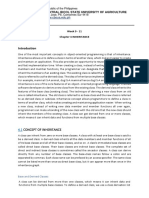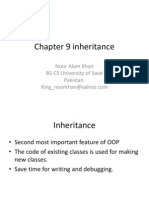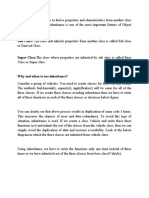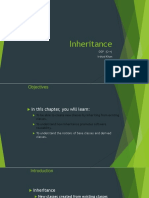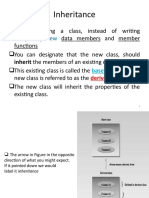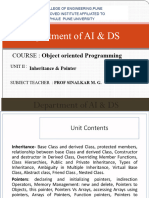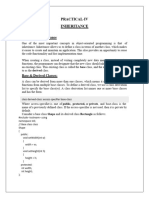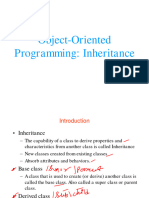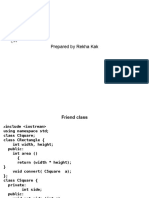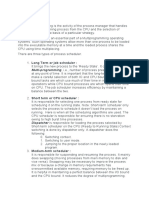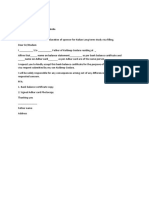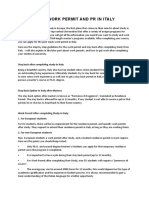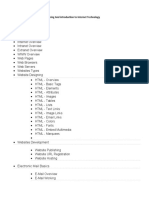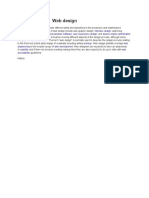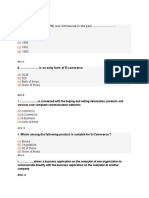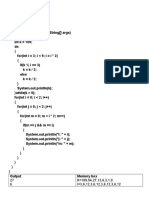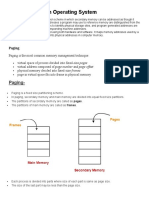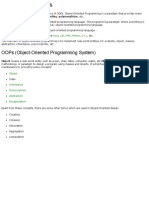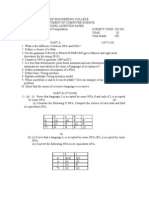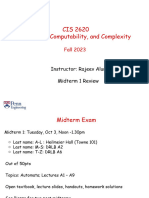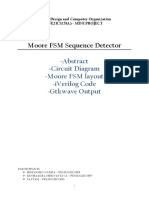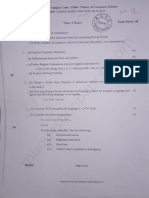C++ Inheritance
One of the most important concepts in object-oriented programming is that of
inheritance. Inheritance allows us to define a class in terms of another class, which
makes it easier to create and maintain an application. This also provides an opportunity
to reuse the code functionality and fast implementation time.
When creating a class, instead of writing completely new data members and member
functions, the programmer can designate that the new class should inherit the
members of an existing class. This existing class is called the baseclass, and the new
class is referred to as the derived class.
The idea of inheritance implements the is a relationship. For example, mammal IS-A
animal, dog IS-A mammal hence dog IS-A animal as well and so on.
Base & Derived Classes:
A class can be derived from more than one classes, which means it can inherit data and
functions from multiple base classes. To define a derived class, we use a class
derivation list to specify the base class(es). A class derivation list names one or more
base classes and has the form:
class derived-class: access-specifier base-class
Where access-specifier is one of public, protected, or private, and base-class is the
name of a previously defined class. If the access-specifier is not used, then it is private
by default.
Consider a base class Shape and its derived class Rectangle as follows:
#include <iostream>
using namespace std;
// Base class
class Shape
public:
void setWidth(int w)
width = w;
}
� void setHeight(int h)
height = h;
protected:
int width;
int height;
};
// Derived class
class Rectangle: public Shape
public:
int getArea()
return (width * height);
};
int main(void)
Rectangle Rect;
Rect.setWidth(5);
Rect.setHeight(7);
// Print the area of the object.
cout << "Total area: " << Rect.getArea() << endl;
return 0;
Type of Inheritance:
When deriving a class from a base class, the base class may be inherited
through public, protected or private inheritance. The type of inheritance is specified
by the access-specifier as explained above.
�We hardly use protected or private inheritance, but public inheritance is commonly
used. While using different type of inheritance, following rules are applied:
Public Inheritance: When deriving a class from a public base class,public members of the
base class become public members of the derived class and protected members of the base
class becomeprotected members of the derived class. A base class's privatemembers are
never accessible directly from a derived class, but can be accessed through calls to
the public and protected members of the base class.
Protected Inheritance: When deriving from a protected base
class,public and protected members of the base class become protectedmembers of the
derived class.
Private Inheritance: When deriving from a private base
class,public and protected members of the base class become privatemembers of the
derived class.
Multiple Inheritances:
A C++ class can inherit members from more than one class and here is the extended
syntax:
class derived-class: access baseA, access baseB....
Where access is one of public, protected, or private and would be given for every
base class and they will be separated by comma as shown above. Let us try the
following example:
#include <iostream>
using namespace std;
// Base class Shape
class Shape
public:
void setWidth(int w)
width = w;
void setHeight(int h)
� {
height = h;
protected:
int width;
int height;
};
// Base class PaintCost
class PaintCost
public:
int getCost(int area)
return area * 70;
};
// Derived class
class Rectangle: public Shape, public PaintCost
public:
int getArea()
return (width * height);
};
int main(void)
Rectangle Rect;
int area;
Rect.setWidth(5);
Rect.setHeight(7);
� area = Rect.getArea();
// Print the area of the object.
cout << "Total area: " << Rect.getArea() << endl;
// Print the total cost of painting
cout << "Total paint cost: $" << Rect.getCost(area) << endl;
return 0;
When the above code is compiled and executed, it produces the following result:
Total area: 35
Total paint cost: $2450














